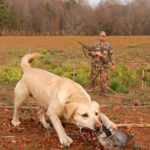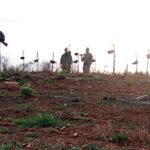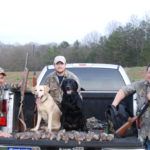
Scout out those Labor Day fields for winter doves, and be ready to shoot them when numbers spike upwards
Dove hunters who think the best shooting of the year is finished about the time college football starts could be missing out if those fields of September gold are forgotten. Within the framework of federal migratory bird-hunting guidelines, South Carolina opens the last segment of dove season in mid-December for nearly a month so wing-shooters can take advantage of resident doves overwintering in South Carolina and migratory birds passing through around the end of the year.
Sportsmen who have grown weary of deer season or who simply like to wield a scattergun can have renewed life if they are willing to put forth a little effort. Steve Crenshaw of Powdersville, a Lake Hartwell fishing guide who helps landowners keep their fields in shape for the late season, said it doesn’t take a lot of effort to revive September fields and make them fresh for late December and January.
“I plant sunflowers typically in May for the early season and then, for late-season doves, I’ll leave those sunflowers standing,” said Crenshaw. “I also plant brown-top millet around July 4, and when I start to see signs that the migratory birds are showing up in December, I’ll burn it.”
Crenshaw said that preparing for the late season is a matter of manipulating the crops he’s left standing – the same crops over which he hunted doves in September and deer in October and November. In fact, he said that the two seasons blend together so well, it’s a shame not to take advantage of late-season opportunities.
“I plow a few strips before we hunt, and I’ll plant wheat for the next season that benefits all of the wildlife on our land, and then we’ll burn millet to coincide with the arrival of the late-season doves,” said Crenshaw, who observes that resident birds seem to thin out after the early season, and similar to waterfowl migrations, when the weather turns cold up north, he starts to see migratory doves moving in.
“Migratory birds are bigger, and they typically show up later in the year, he said. “I’m watching this field through most of the fall, usually from a deer stand, and as far as the doves go, you’ll have a lull. There won’t be any birds here, and then, all of a sudden, the larger birds will show up.”
Hunting doves in late December and January is a far cry from hunting them in September and hunters who come with an early season mentality are going to go home frustrated and disappointed. Crenshaw said the majority of birds in his winter flocks are migratory doves, which behave altogether differently than the resident birds that used the field four months ago.
“The migratory birds fly higher and faster,” he said. “They’ve already been shot at during the year. Early season birds will mill around, giving you two or three chances at them. These birds are more interested in getting something to eat, then moving on to the next spot. But as far as shooting, it’s some of the best of the year.”
Brent McLaurin, Crenshaw’s hunting partner, said late-season hunters need to adapt to the season; he prefers not to skimp on late-season dove hunts, especially when winter conditions dictate more firepower than the early season.
“You’re looking at higher gauge guns, typically 12-gauge versus 20-gauge guns,” he said. “You’re looking at generally higher- power loads. You don’t want your lighter loads; you want your heavier powder loads, and you want your heavier shot loads, because these birds are tough.”
McLaurin compared his early season set-up to his late season arsenal.
“For the early season, just like most of the field, I’m shooting low brass shells with between Nos. 8 and 9 shot. If you’re using anything less than 7½, you’re going to tear the birds up,” he said. “Late season, I shoot a modified 12 gauge, and probably either a high-brass 7½ or maybe even No. 6 shot.”
Crenshaw agrees.
“Late season, you want your tighter chokes,” he said. “You want your heavier shot sizes. You want your heavier powder burdens.”
Another aspect that factors into late season dove hunts are smaller hunting parties. These hunts tend to be less-traditional affairs with more running and gunning that sweating, eating barbecue and drinking sweet tea.
“We don’t hunt as many people on late-season hunts as we do early seasons. We take longer shots and use a tighter choke,” Crenshaw said. “You’re really almost encouraged to — I won’t say sky busting — but you’re encouraged to take a little bit longer shot because you’ve got the fire power to go out there and get them, and you’ve got a heavier load.”
Crenshaw said it’s also a matter of available cover. Since the leaves and most of the other foliage is gone, his hunters have to make due with what’s left in the field and often move frequently during the hunt to keep the birds stirred up and flying.
“Typically, we’ve got limited to no cover. With the cover so sparse, you can’t hunt as many people. We work the hay bales up. You hunt maybe five or six shooters on an 8- to 10-acre field, take a little bit longer shots and pick up and go to the birds if you see them congregating in one spot where no one else is in range,” he said.
A final aspect that Crenshaw and McLaurin find imperative is to hunt birds when you have them. Unlike early season doves that will hang around for a while, late migrants are here today, gone tomorrow.
“It’s very important to do your scouting and know what’s on your field,” Crenshaw said, “because they’re constantly migrating in the fall — you may have them one day and not the next — you need to check and see. And when you do have them, you need to shoot them.”
Most times, migrations will coincide with weather; cold fronts will push doves. The downside is when the birds are on your field, a front pushing through is likely to push them to fairer climates.
“When there’s a strong front coming in, they’ll move,” Crenshaw said. “We saw these birds Friday and shot them on Sunday, but typically, you don’t know how long you’ve got. You might have a day or two; you might have a week. If you see birds, you need to shoot them before another front comes along and pushes them further south.”
DESTINATION INFORMATION
WHERE TO HUNT — For dove hunters who do not have access to private lands, The S.C. Department of Natural Resources maintains public dove fields across the state, and most of these fields are deserted after the first season. These locations offer intensely managed areas of harvested grain fields that doves will find attractive at different times, depending on when the planted crops mature. A listing of these fields is available at www.dnr.sc.gov/wildlife/dove/pdf/dovefields20132014.pdf
SEASON DATES/REGULATIONS — The final segment of the 2013-14 dove season opens Dec. 19 and lasts through Jan. 15. Legal hunting hours are 30 minutes before sunrise until sunset. The daily bag limit is 15 birds.
EQUIPMENT — Don’t expect late-season doves to fly like opening day birds. Anticipate longer shots. To prepare for this, 12-gauge guns, modified chokes and high-brass loads in Nos. 6 and 7½ shot will fare better against higher flying and typically bigger migratory doves than the cheaper stuff you would use around Labor Day.
HUNTING INFO/GUIDES — Steve Crenshaw, 864-608-2763, www.lakehartwellfishingcharters.com; Billy Dukes, SCDNR, 803-734-3886, www.dnr.sc.gov; Region 1, 864-654-1671; Region 2, 843-661-4766; Region 3, 803-734-3886; Region 4, 843-953-5291.
MAPS — WMA maps, S.C. Department of Natural Resources, www.dnr.sc.us; Delorme South Carolina Atlas & Gazetteer, 800-561-5105, www.delorme.com.







Be the first to comment